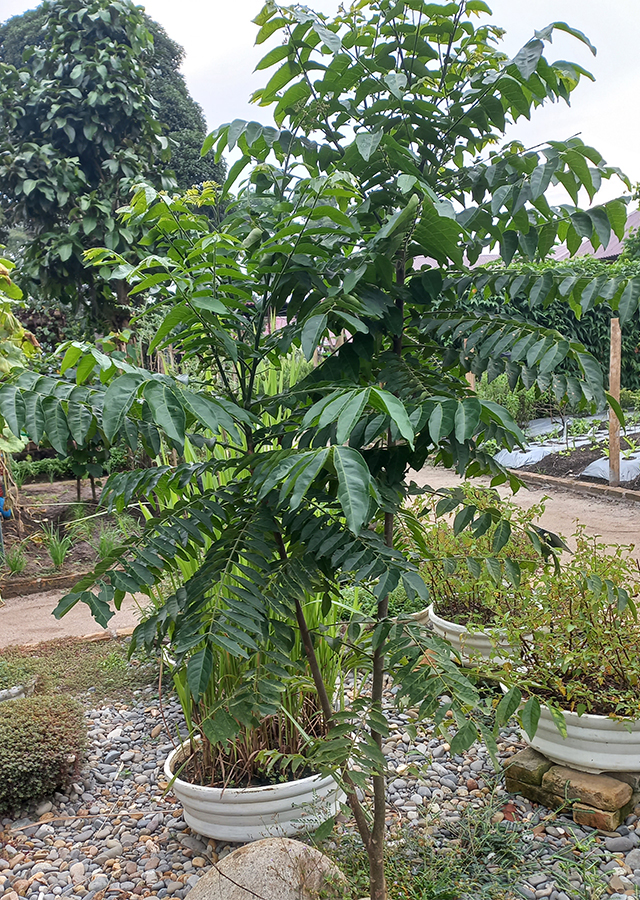Traditional Herbs from Clausena excavata
obat_cacing
- Prepare 9 fresh ratan leaves.\u00a0
- Then wash them until clean. and cut the leaves into small pieces.
- Boil the water until it boils then turn off the heat.
- Add the leaves and wait until warm.
- After warm\u00a0then drink.
diarrhea_and_dysentery
- Take 9 fresh leaves of ratan.\u00a0
- Then wash until clean.and cut small pieces of leaves.
- Break the leaves with 1 cup of boiling water, wait a few minutes.
- Drink while warm.
What is Clausena excavata Looks like??



Parts of Clausena excavata that could be used
- Leaves
- Bark
- Flowers
- Roots
- Stems
Clausena excavata Distribution
Clausena excavata is a plant that is widespread in tropical and subtropical areas of Asia. Distributed from India, Myanmar, South China, Taiwan, South Thailand through Malaysia, Singapore, Philippines, Indonesia and Brunei to Papua New Guinea. This plant has many health benefits, and has been used in various countries as an ingredient in traditional medicine. Based on research, it is known that Clausena excavata leaves are rich in active ingredients that can suppress infectious bacteria and function as an antibacterial. In Indonesia, especially Javanese people use the leaves to treat worms (vermifuge), while in West Sumatra they are mainly used to treat diarrhea. In India, this plant is used to facilitate urination and relieve flatulence. Apart from being a medicinal plant, the leaves of Clausena excavata are also used by the Tamil people as a vegetable, where the leaves have a curry-like fragrance when crushed. In the cosmetics industry, it is known that the leaves and bark contain essential oils that can be used in the perfume industry.Agroecology of Clausena excavata
Rats are often found in secondary forests, bushes and forests around villages, at altitudes up to 1,300 m above sea level. Its growth prefers areas with full sunlight (6-8 hours per day), but is tolerant of partial shade, with a moderate level of water requirements.
Morphology of Clausena excavata
- Tap root, dirty white.
- Stem round, branched, covered with fine hairs, woody, and dirty green.
- Compound leaves with 7-20 pairs of leaves, alternate or scattered leaves, stemmed short, thin and rough leaf blades, ovate-lanceolate with rounded and asymmetrical leaf bases, tapered leaf tips, wavy or slightly curved leaf edges, green in color, smooth upper surface, smooth surface The underside is sparsely hairy. The leaf blades are pinnately bony. When crushed, they release an aroma.
- Flowers are bisexual, small, pubescent, have petals which are usually 4-lobed. The crown is 4-5 lobed, oval in shape, white or white-yellow. Pale. The stamens are 8 in number and have white stems, the anthers are whitish yellow, the pistils have yellowish green stems, the stigmas are purplish yellow, found on pyramidal, branched panicles numerous, appearing at the tip of the stem.
- Buni fruit, fleshy, smooth texture, egg-shaped, transparent. Ripe fruit is green-pink in color, fruit is found on hanging shoots. If crushed, it gives off a sour smell.
- There are 1-2 seeds per fruit, egg-shaped, green with white stripes.
Cultivation of Clausena excavata
Propagation is done generatively using seeds.
Clausena excavata, more details :
Chemical Content of Clausena excavataPhenolics, quercetin, myricetin, kaempferol, carbazole alkaloids (clausine-B, -H, -M, -N, -O, -P, -Q, -R, -S, -U, -V, -Z, clausenatine- A, clausenamine D, E, F, G, clauszoline-A, -B, -C, -D, -E, -F, -G, -H, -I, -J, -K, -L, -M, 3-carbomethoxy-2-hydroxy-7-methoxycarbazole, clausenol, clausenine), biscarbazole alkaloid (clausemine-A ), carbazole derivatives (3-formylcarbazole, mukonal, 3-methoxycarbonylcarbazole, murrayanin, 2 -hydroxy-3-formyl-7-methoxycarbazole), coumarin (excavacoumarin A,B, C, D, E, F, and G, clausenaexcavin, clauslactones A, B, C, D, E, F, G, H, I, and J), limonoids (clausenolide-1-ethylether, clausenarin, clausenolide-1- metylether), essential oils (beta-caryophyllene, germacrene B, and beta-phellandrene).
Benefits of Clausena excavata
Treats diarrhea and dysentery, wounds, high blood pressure, toothache, headaches, fever, yaws, nasal ulcers, colic, worm medicine, improves urination, cough medicine, snake bites, detoxification, improves menstruation. Has activity as anticancer, immunomodulator, anti-HIV-1, antioxidant, antibacterial, insecticide, antifungal, antinociceptive and antimalarial.
Simplisia of Clausena excavata
Another Facts for Clausena excavata :
Synonym of Clausena excavataLawsonia falcata Lour., Amyris punctata Roxb. ex Colebr., Murraya burmanni Spreng.
Habitus of Clausena excavata
Tree. Shrub or small tree, annual, reaching 15 cm high
Habitat of Clausena excavata
- Forest
- Land
No comments:
Post a Comment